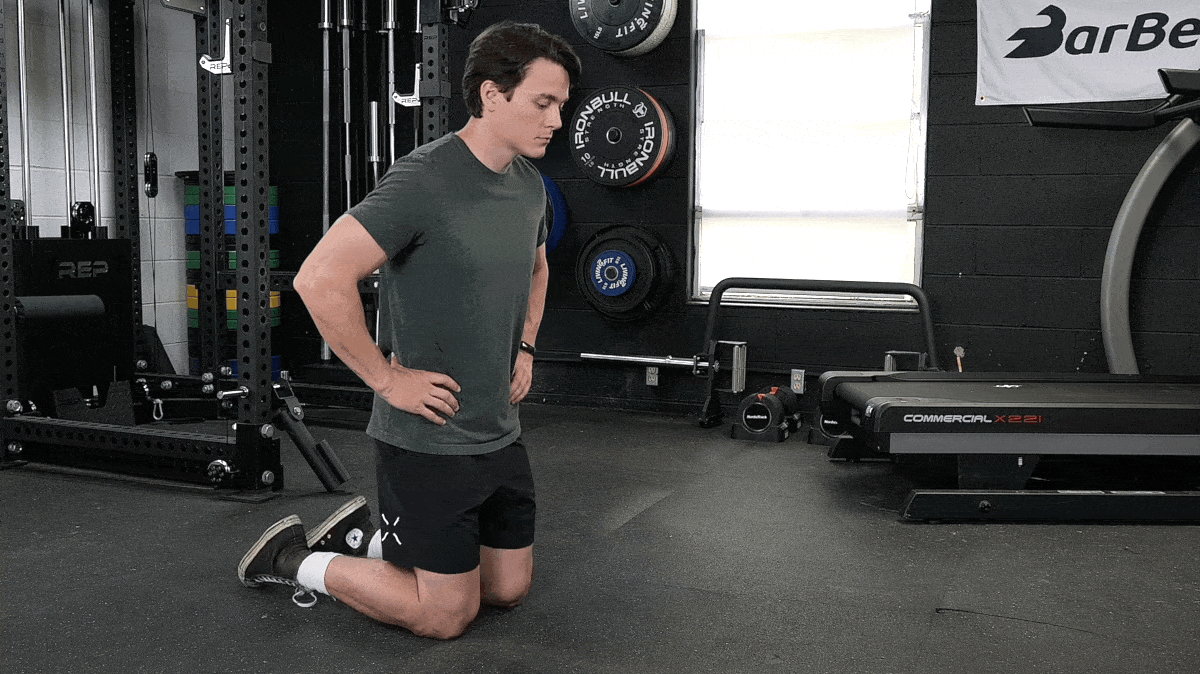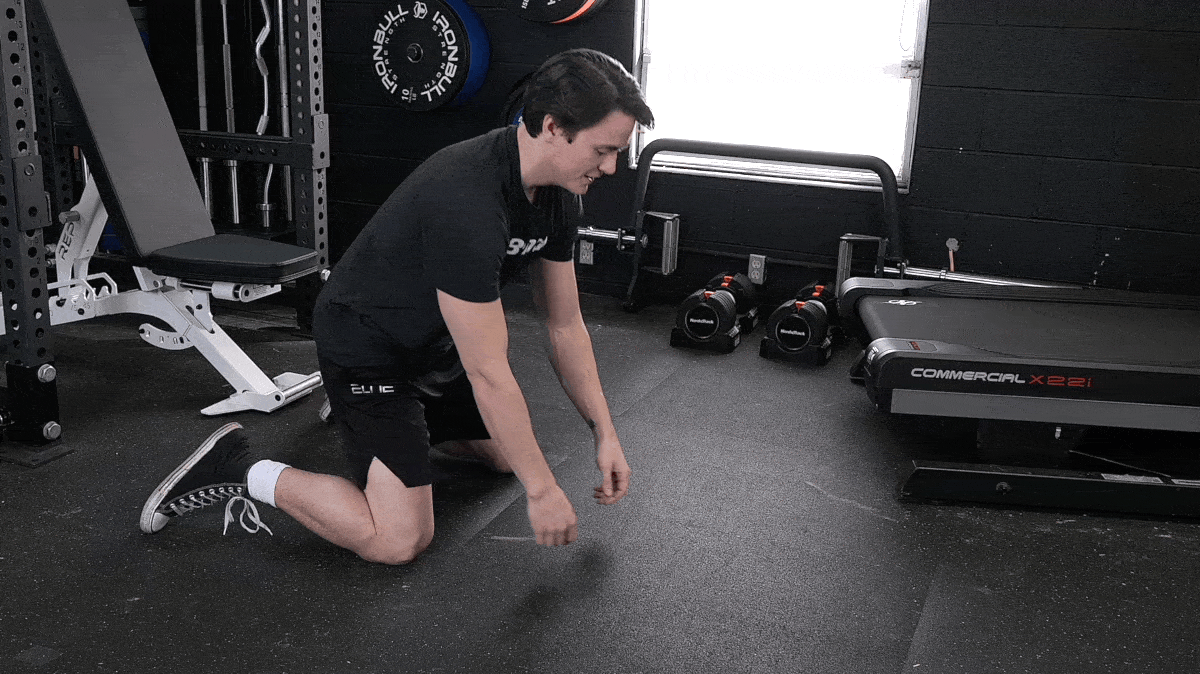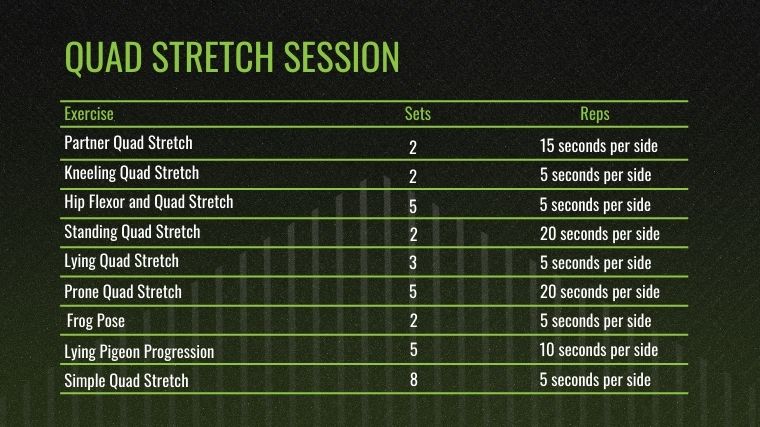If you want to build muscle, you need to target specific muscle groups. Chasing those teardrop quads? Yes, you need to do your lunges and get in those lower body exercises galore. But you’ve also got to stretch your quads to make the most of your workouts and recovery, fighting off soreness and potential knee pain along the way.

You don’t need to be in the physical therapy office to get in your stretches. Check out these nine best quad stretches to ease your muscles into rest mode after an intense workout. You’ll give your thighs the care they need to recover and build muscle quickly.
Best Quad Stretches
- Partner Quad Stretch
- Kneeling Quad Stretch
- Hip Flexor and Quad Stretch
- Standing Quad Stretch
- Lying Quad Stretch
- Prone Quad Stretch
- Frog Pose
- Lying Pigeon Progression
- Simple Quad Stretch
1. Partner Quad Stretch
| Equipment Needed | Bodyweight-only, yoga mat (optional) |
| Muscles Worked | Quads |
| Sets & Reps | 2–4 sets of 15 seconds per side |
The partner quad stretch doubles as a warmup or cool-down stretch, maximizing your opportunities to prepare your muscles for working out or healing. I love doing this movement whenever my gym trip involves a partner because it’s a quick and easy way to ease my thighs into recovery mode.
How to Do It:
- Lie down with your shins, quads, and chest against the floor.
- Hold your feet up in the air by bending your knees.
- Ask your partner to gently grab your ankles and push them toward your glutes.
- Hold this position for at least 15 seconds and switch sides before repeating.
- Rocking your shins side to side is optional if you feel extra tight.
Modifications
- Make it Easier: Cross your arms beneath your head and rest on them like a pillow during this stretch. This will prevent straining your neck.
- Make it Harder: Hold your arms up and out to the sides while lifting your chest off the ground. Maintaining this “superman” pose while your partner stretches your quads will work your abdominal muscles as you stretch.
2. Kneeling Quad Stretch

| Equipment Needed | Bodyweight-only, kneeling pad (optional) |
| Muscles Worked | Quads |
| Sets & Reps | 5–10 sets of 5 seconds per side |
Kneeling quad stretches are beneficial after any workout, but they are extra helpful after a long run or squat session when your quadriceps muscles have worked extra hard. You’ll stretch every quad muscle without requiring a partner or machinery.
How to Do It:
- Kneel on your right knee and position your left foot in front of your body. Your left leg should bend at a 90-degree angle in front of you.
- Move your front foot an inch or two farther out. It should leave enough room to lean forward comfortably without losing your balance.
- Press your hips forward while keeping your back straight. Your left knee should shift forward over your toes but not past them.
- Hold for 30 seconds and lean back before repeating this move on each side.
Modifications
- Make it Easier: Place a kneeling pad on the floor and use it to cushion your knees during this stretch. You might feel more comfortable and able to continue this quad stretch longer.
- Make it Harder: Grab a pair of light weights and do reverse flies or front raises every time you lean forward. I appreciate being able to sneak an extra workout into my routine without skipping my stretch time to keep up with my busy schedule. You might, too!
3. Hip Flexor and Quad Stretch
| Equipment Needed | Bodyweight-only, yoga mat (optional) |
| Muscles Worked | Quads |
| Sets & Reps | 5–8 sets of 5 seconds per side |
Lifting weights or engaging in cardio exercises activates your quads and hips. Ease both into a looser state with this hip flexor and quad stretch that makes movements easier during workouts.
How to Do It:
- Lie on your left side on the floor, extending your legs straight like a pencil.
- Raise your left hand to your head and lean on it for support.
- Bend your right knee and place your other hand on your right ankle.
- Pull your right ankle up to your glutes. You should feel the front of your thigh stretching.
- Hold for at least five seconds and release.
- Repeat on each side.
Modifications
- Make it Easier: Lie down where the ground is soft, like on a carpet or thick exercise mat. You can also fold a pillow under your head to support your neck more easily.
- Make it Harder: Hold this stretch for over five seconds while pulling your ankle to the top of your glutes or lower back, depending on your natural flexibility.
4. Standing Quad Stretch

| Equipment Needed | Bodyweight-only, chair (optional) |
| Muscles Worked | Quads |
| Sets & Reps | 2–4 sets of 20 seconds per side |
[Read More: Try These Tight Calves Stretches to Improve Ankle Mobility]
The standing quad stretch can happen anywhere, so adding it to your home life or gym routine is easy. I use this movement to gently pull on the front of my thigh when I find it hard to squat, use a stair climber, or sit.
How to Do It:
- Stand straight and grab your right ankle in your right hand.
- Bend your knee back, pulling your foot to your glutes.
- Hold your free arm straight out to the side for balance.
- Maintain this position for 20 seconds while staying upright.
- Repeat this movement on each side.
Modifications
- Make it Easier: Hold onto a chair in front of you for better balance.
- Make it Harder: Stand on a small raised platform during this stretch and hold your arm to the side for balance. You’ll work your calf muscles while stretching your opposite leg.
5. Lying Quad Stretch

| Equipment Needed | Bodyweight-only, foam roller |
| Muscles Worked | Quads, abs |
| Sets & Reps | 3–5 sets of 5 seconds each |
The lying quad stretch is one of the best quad stretches. You’ll use a foam roller to maximize your recovery by applying light pressure to your sore thigh muscles.
How to Do It:
- Place a foam roller on the floor and position it horizontally.
- Lie on the floor on top of it, placing the foam roller just under your quads.
- Prop yourself on your forearms to hold a plank position while putting your body weight on the foam roller.
- Lean forward and back on your elbows to slowly move your quadriceps up and down the foam roller.
- Repeat this motion for at least five seconds and rest by sitting next to the foam roller between sets.
Modifications
- Make it Easier: Sit on the floor with your legs extended in front of you. Move the foam roller up and down the top of your thighs with as much pressure as you can comfortably manage.
- Make it Harder: Wear ankle weights during this stretch to engage your core muscles more intensely and apply greater pressure on the muscles in contact with the foam roller.
6. Prone Quad Stretch

| Equipment Needed | Bodyweight-only, a medium resistance band |
| Muscles Worked | Quads |
| Sets & Reps | 5–10 sets of 20 seconds each |
[Read More: Stretches and Warm-ups to Improve Ankle Mobility]
Resistance bands are helpful when targeting your leg muscles or upper arms. Use this stretch to banish thigh tension without straining to hold your ankle.
How to Do It:
- Lie down with your shins, quads, and chest against the floor.
- Loop a medium resistance band around your right ankle and hold it over your right shoulder.
- Prop yourself on your elbows and use both hands to pull the resistance band over your shoulder toward the floor.
- Press your pelvic bone into the floor if you don’t feel enough tension.
- Hold for at least 20 seconds and switch sides before repeating.
Modifications
- Make it Easier: Use a light resistance band to ease the tension on your quads if you’re too tight or have limited flexibility.
- Make it Harder: Lift your knee off the ground as you pull your ankle toward your glutes to increase how much you can pull on your rectus femoris.
7. Frog Pose

| Equipment Needed | Bodyweight-only, yoga mat (optional) |
| Muscles Worked | Quads |
| Sets & Reps | 2–5 sets of 5 seconds each |
People often enjoy the frog pose when they’re too flexible for standard quad stretches. It also doubles as an advanced yoga pose you can add to any yoga routine on your rest days.
How to Do It:
- Lie down with your shins, quads, and chest against the floor.
- Prop yourself on your left elbow.
- Grab your right ankle with your right hand and pull it to your quad.
- Grab your left ankle with your left hand and pull it to your quad.
- Pull both ankles to the sides of your hip, arching your back to accommodate the movement.
- Hold for five seconds and release.
Modifications
- Make it Easier: Perform this quadriceps stretch on a cushioned surface, like thick carpeting. Depending on your flexibility, try holding both feet to your glutes or closing them.
- Make it Harder: Hold this pose for 10 seconds or longer, pointing your toes to stretch your calf muscles.
8. Lying Pigeon Progression
[Read More: How to Do the 90/90 Stretch to Squat Heavier and Move Better]
| Equipment Needed | Bodyweight-only, a medium resistance band |
| Muscles Worked | Quads, abs |
| Sets & Reps | 5–10 sets of 10 seconds each |
The lying pigeon stretch resembles the prone quad stretch but involves a partner. Many people find this makes the pose easier to hold by reducing their back strain.
How to Do It:
- Lie down with your shins, quads, and chest against the floor.
- Loop a medium resistance band around your right ankle and hold it over your right shoulder.
- Give your partner the resistance band and hold your arms in front of you like you’re diving into a ring.
- Ask your partner to gently pull on the band for 10 seconds while you lift your chest off the ground to engage your core muscles.
- Press your tailbone into the floor if you don’t feel enough muscle tension.
- Hold for at least 20 seconds and repeat on each side.
Modifications
- Make it Easier: Extend each leg so they’re flat on the ground between sets. This will instantly reduce any tension you feel before the next round.
- Make it Harder: Wrap a resistance band around your ankles and have your partner pull it to utilize both sets of quad muscles simultaneously.
9. Simple Quad Stretch
[Read More: The Best Foam Roller Exercises For Your Legs]
| Equipment Needed | Bodyweight-only, yoga mat (optional) |
| Muscles Worked | Quads, biceps, abs |
| Sets & Reps | 8–12 sets of 5 seconds each |
Ease your quads with this simple stretch that only requires floor space. You’ll reduce your muscle tension while leaning on your biceps, adding a gentle arm workout to your dynamic warmup or cool-down routine.
How to Do It:
- Kneel on the ground and sit on your heels, keeping your back straight.
- Place both hands flat on the floor behind you.
- Lean backward to stretch your quads.
- Lift your hips in the air and hold for five seconds.
- Repeat on each side.
Modifications
- Make it Easier: Sit on a thick kneeling block to lift your hips without working your abs.
- Make it Harder: Pulse your hips in the air for 10 seconds to increase the intensity of this stretch.
Sample Quad Stretch Session
Use this sample quad stretch session guide to start reducing tension in your thigh muscles. You’ll get to know how each movement feels and what’s best for your body without potentially skipping sets or reps.

- Partner Quad Stretch: 2 x 15 seconds per side
- Kneeling Quad Stretch: 2 x 5 seconds per side
- Hip Flexor and Quad Stretch: 5 x 5 seconds per side
- Standing Quad Stretch: 2 x 20 seconds per side
- Lying Quad Stretch: 3 x 5 seconds per side
- Prone Quad Stretch: 5 x 20 seconds per side
- Frog Pose: 2 x 5 seconds per side
- Lying Pigeon Progression: 5 x 10 seconds per side
- Simple Quad Stretch: 8 x 5 seconds per side
[Read More: The Best Leg Stretches to Bolster Your Lower Body Training]
Equipment Needed: In addition to your partner, you’ll need a yoga mat, chair, foam roller, and medium resistance band. You could also choose an area with a thick rug or carpet to cushion your pelvis and tailbone if preferred.
Modifications
Make it Easier:
- Do these stretches on a soft surface to reduce the pressure on your tailbone or pelvic bones.
- Lean on a chair or partner for stretches that require balance.
- Don’t pull on your ankles too hard in the frog pose if you have limited flexibility.
Make it Harder:
- Use the tips beneath these individual stretches to increase the intensity of each movement.
- Hold the positions for five to 10 seconds longer.
What Muscles Make Up the Quads?
Your quadriceps include four muscle groups listed below. They make leg extensions, jumping, and walking possible. Although you use them daily, your thighs are more susceptible to muscle loss as you get older than your lower legs, so it’s essential to work them out regularly. (1)
- Rectus Femoris: This muscle connects with your hip joints, allowing thigh flexes.
- Vastus Lateralis: This quad muscle extends your lower leg and helps raise you from squats.
- Vastus Medialis: This part of your quads helps your knee bend.
- Vastus Intermedius: This muscle supports your knee as it bends and directs blood flow to other quad muscles as a major femoral artery conductor.
Benefits of Stretching Your Quads
Check out these benefits of stretching your quads to motivate yourself during future routines. I’ve noticed these benefits have improved my workouts over time because they helped my thighs get stronger by targeting my tight quadriceps between gym trips.
You May Experience Less Back Pain
Lower back pain is the worst. It makes everything from sitting at work to driving your car uncomfortable. Stretching your quads regularly might help reduce lower back pain because tight leg muscles pull on the lower back.
You May Make Workout Injuries Less Likely
Quad stretches increase your range of motion, which is essential if you work out regularly. I’d never want to start exercising if my muscles were tight. Stretching your quads makes movement safer because you can do the exercises without muscle strain on cold muscles.
You Can Exercise Longer
When your quads are tight, people accommodate the pain by slouching or not extending their legs fully during workouts. Suboptimal posture may indeed increase your risk of injury, and you might also have to shorten your routines. Research shows that certain postures increase fatigue while exercising, reducing the length of each movement. (2)
Frequently Asked Questions
If you’re unsure how to work with your quad muscles, check out some of the questions people wonder about them. You’ll get the answers you need to feel confident about your next addition to your stretching routine.
How do you loosen tight quads?
Stretch your quads before and after your workouts to loosen them. You’ll feel more limber when exercising and prevent extra tightness when your quads need to recover from your latest gym trip.
What causes extremely tight quads?
Tight quads may be a result of working your thighs during a training session. It can mean that your muscles experienced the exercise-related trauma necessary to mend and build additional muscle mass.
If you experience tight quads without working out, a doctor or physical therapist can help identify other potential factors causing your discomfort.
When are quad stretches a bad idea?
Quad stretches are a bad idea when gentle movements cause noticeable discomfort. You could accidentally make your thigh pain worse by stretching them when you’re hurting. Talk with a doctor if you can’t do quad movements without significant to severe pain for accurate assessment and treatment.
Editor’s Note: The content on BarBend is meant to be informative in nature, but it should not be taken as medical advice. When starting a new training regimen and/or diet, it is always a good idea to consult with a trusted medical professional. We are not a medical resource. The opinions and articles on this site are not intended for use as diagnosis, prevention, and/or treatment of health problems. They are not substitutes for consulting a qualified medical professional.
References
- Fuchs, C. J., Kuipers, R., Rombouts, J. A., Brouwers, K., Schrauwen-Hinderling, V. B., Wildberger, J. E., Verdijk, L. B., & van Loon, L. J. C. (2023). ‘Thigh muscles are more susceptible to age-related muscle loss when compared to lower leg and pelvic muscles,’ Experimental Gerontology, 175, 112159.
- Lu, L., Robinson, M., Tan, Y., Goonewardena, K., Guo, X., Mareels, I., & Oetomo, D. (2020). ‘Effective assessments of a short-duration poor posture on upper limb muscle fatigue before physical exercise,’ Frontiers in Physiology, 11.